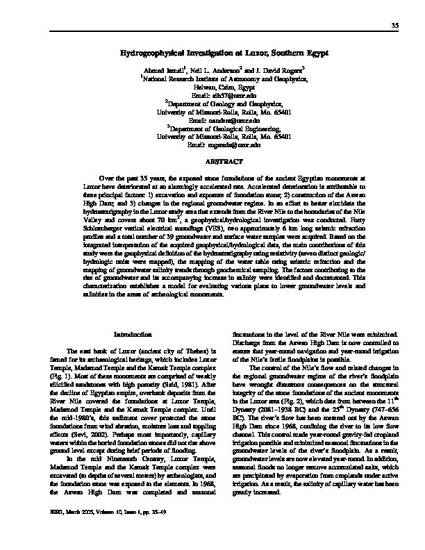
Over the past 35 years, the exposed stone foundations of the ancient Egyptian monuments at Luxor have deteriorated at an alarmingly accelerated rate. Accelerated deterioration is attributable to three principal factors: 1) excavation and exposure of foundation stone; 2) construction of the Aswan High Dam; and 3) changes in the regional groundwater regime. In an effort to better elucidate the hydrostratigraphy in the Luxor study area that extends from the River Nile to the boundaries of the Nile Valley and covers about 70 km2, a geophysical/hydrological investigation was conducted. Forty Schlumberger vertical electrical soundings (VES), two approximately 6 km long seismic refraction profiles and a total number of 39 groundwater and surface water samples were acquired. Based on the integrated interpretation of the acquired geophysical/hydrological data, the main contributions of this study were the geophysical definition of the hydrostratigraphy using resistivity (seven distinct geologic/hydrologic units were mapped), the mapping of the water table using seismic refraction and the mapping of groundwater salinity trends through geochemical sampling. The factors contributing to the rise of groundwater and its accompanying increase in salinity were identified and documented. This characterization establishes a model for evaluating various plans to lower groundwater levels and salinities in the areas of archeological monuments.
- Flooding,
- Floodplain,
- Hydrogeophysics,
- Vertical Electrical Sounding (VES),
- Algorithms,
- Database Systems,
- Evaporation,
- Groundwater,
- Hydrology,
- Sandstone,
- Stratigraphy,
- Geophysics,
- Archaeology,
- Geophysical Survey,
- Africa,
- Eastern Hemisphere,
- Egypt,
- North Africa,
- World
Available at: http://works.bepress.com/j-rogers/31/
